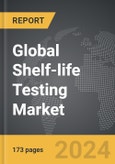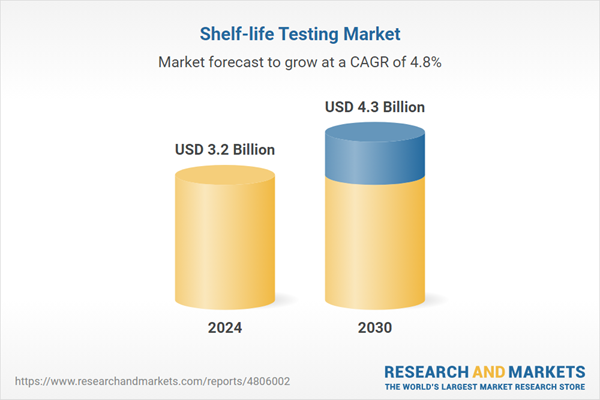The global market for Shelf-life Testing was valued at US$3.2 Billion in 2024 and is projected to reach US$4.3 Billion by 2030, growing at a CAGR of 4.8% from 2024 to 2030. This comprehensive report provides an in-depth analysis of market trends, drivers, and forecasts, helping you make informed business decisions. The report includes the most recent global tariff developments and how they impact the Shelf-life Testing market.
Segments: Parameter (Microbial Contamination, Rancidity, Nutrient Stability, Organoleptic Properties, Other Parameters); Technology (Equipment & Kit Testing, Manual Testing); End-Use (Processed Fruits & Vegetables, Beverages, Dairy Products, Packaged Food, Bakery & Confectionery, Meat & Meat Products, Other End-Uses).
Geographic Regions/Countries: World; United States; Canada; Japan; China; Europe (France; Germany; Italy; United Kingdom; Spain; Russia; and Rest of Europe); Asia-Pacific (Australia; India; South Korea; and Rest of Asia-Pacific); Latin America (Argentina; Brazil; Mexico; and Rest of Latin America); Middle East (Iran; Israel; Saudi Arabia; United Arab Emirates; and Rest of Middle East); and Africa.
The analysts continuously track trade developments worldwide, drawing insights from leading global economists and over 200 industry and policy institutions, including think tanks, trade organizations, and national economic advisory bodies. This intelligence is integrated into forecasting models to provide timely, data-driven analysis of emerging risks and opportunities.
Global Shelf-life Testing Market - Key Trends and Drivers Summarized
Why Is Shelf-Life Testing Becoming Indispensable for Food and Pharmaceutical Industries?
Shelf-life testing is becoming indispensable for food and pharmaceutical industries as it ensures product quality, safety, and compliance with regulatory standards. By determining the stability, microbial safety, and nutritional integrity of products over time, shelf-life testing helps manufacturers guarantee that their products meet consumer expectations and remain safe for consumption throughout their designated shelf life. The growing demand for longer shelf life, reduced food waste, and extended product freshness in the food and beverage sector is driving the adoption of advanced shelf-life testing methods. Similarly, in the pharmaceutical industry, accurate shelf-life determination is critical for maintaining the efficacy and safety of drugs, vaccines, and biologics, especially in a highly regulated environment.How Are Technological Advancements Revolutionizing Shelf-Life Testing?
Technological advancements are revolutionizing shelf-life testing by enhancing accuracy, speed, and reliability. The use of advanced analytical techniques, such as gas chromatography, mass spectrometry, and high-performance liquid chromatography (HPLC), is enabling precise detection of chemical changes, spoilage, and degradation in food and pharmaceutical products. The integration of sensor technologies, digital quality control, and data analytics is providing real-time monitoring of temperature, humidity, and microbial activity, allowing for proactive shelf-life management and predictive modeling. Innovations in non-destructive testing, accelerated testing methods, and multi-parameter analysis are reducing testing times, lowering costs, and providing comprehensive insights into product stability. Additionally, the development of cloud-based platforms for remote testing, data sharing, and regulatory compliance is enhancing collaboration, transparency, and decision-making across the supply chain.Which Market Segments Are Leading the Adoption of Shelf-Life Testing?
Parameter types include microbial contamination, chemical degradation, physical stability, and sensory quality, with microbial contamination and chemical degradation being the most widely tested due to their critical impact on product safety and quality. Technologies used in shelf-life testing include gas chromatography, mass spectrometry, HPLC, spectroscopy, and accelerated shelf-life testing methods, with HPLC and spectroscopy leading the market due to their high sensitivity, accuracy, and versatility. End-users include food and beverage manufacturers, pharmaceutical companies, cosmetics producers, and research laboratories, with food and beverage manufacturers being the largest segment due to the stringent safety and quality standards in the industry. Asia-Pacific is emerging as a high-growth region driven by the rapid expansion of the food and pharmaceutical industries.What Are the Key Drivers of Growth in the Shelf-Life Testing Market?
The growth in the shelf-life testing market is driven by several factors, including the increasing demand for quality assurance, food safety compliance, and longer shelf life in food, pharmaceutical, and cosmetics industries, advancements in analytical techniques, sensor technologies, and data analytics, and the rising adoption of shelf-life testing for ready-to-eat foods, functional foods, and clean label products. The development of non-destructive testing, rapid detection, and multi-parameter analysis methods with enhanced predictive modeling, real-time monitoring, and accelerated testing capabilities is driving market adoption among food and beverage manufacturers, pharmaceutical companies, and cosmetics producers. The focus on enhancing test method standardization, accuracy, and cost management is expanding the market reach among cold chain management, retail, and distribution applications. The growing use of shelf-life testing for allergen detection, nutritional stability, and microbial safety, coupled with the demand for digital quality control, remote testing, and cloud-based data management, is creating new opportunities for market growth. Additionally, the increasing investments in R&D for shelf-life testing solutions for organic, gluten-free, and plant-based products are further supporting market expansion.Report Scope
The report analyzes the Shelf-life Testing market, presented in terms of units. The analysis covers the key segments and geographic regions outlined below.Segments: Parameter (Microbial Contamination, Rancidity, Nutrient Stability, Organoleptic Properties, Other Parameters); Technology (Equipment & Kit Testing, Manual Testing); End-Use (Processed Fruits & Vegetables, Beverages, Dairy Products, Packaged Food, Bakery & Confectionery, Meat & Meat Products, Other End-Uses).
Geographic Regions/Countries: World; United States; Canada; Japan; China; Europe (France; Germany; Italy; United Kingdom; Spain; Russia; and Rest of Europe); Asia-Pacific (Australia; India; South Korea; and Rest of Asia-Pacific); Latin America (Argentina; Brazil; Mexico; and Rest of Latin America); Middle East (Iran; Israel; Saudi Arabia; United Arab Emirates; and Rest of Middle East); and Africa.
Key Insights:
- Market Growth: Understand the significant growth trajectory of the Microbial Contamination segment, which is expected to reach US$2.0 Billion by 2030 with a CAGR of a 6.2%. The Rancidity segment is also set to grow at 5.1% CAGR over the analysis period.
- Regional Analysis: Gain insights into the U.S. market, valued at $847.2 Million in 2024, and China, forecasted to grow at an impressive 8.6% CAGR to reach $1.0 Billion by 2030. Discover growth trends in other key regions, including Japan, Canada, Germany, and the Asia-Pacific.
Why You Should Buy This Report:
- Detailed Market Analysis: Access a thorough analysis of the Global Shelf-life Testing Market, covering all major geographic regions and market segments.
- Competitive Insights: Get an overview of the competitive landscape, including the market presence of major players across different geographies.
- Future Trends and Drivers: Understand the key trends and drivers shaping the future of the Global Shelf-life Testing Market.
- Actionable Insights: Benefit from actionable insights that can help you identify new revenue opportunities and make strategic business decisions.
Key Questions Answered:
- How is the Global Shelf-life Testing Market expected to evolve by 2030?
- What are the main drivers and restraints affecting the market?
- Which market segments will grow the most over the forecast period?
- How will market shares for different regions and segments change by 2030?
- Who are the leading players in the market, and what are their prospects?
Report Features:
- Comprehensive Market Data: Independent analysis of annual sales and market forecasts in US$ Million from 2024 to 2030.
- In-Depth Regional Analysis: Detailed insights into key markets, including the U.S., China, Japan, Canada, Europe, Asia-Pacific, Latin America, Middle East, and Africa.
- Company Profiles: Coverage of players such as Agrifood Technology, ALS Ltd., AsureQuality Ltd., Bureau Veritas SA, Eurofins Scientific SE and more.
- Complimentary Updates: Receive free report updates for one year to keep you informed of the latest market developments.
Some of the 46 companies featured in this Shelf-life Testing market report include:
- Agrifood Technology
- ALS Ltd.
- AsureQuality Ltd.
- Bureau Veritas SA
- Eurofins Scientific SE
- Intertek Group PLC
- Merieux NutriSciences
- Microchem Lab Services (Pty.) Ltd.
- Premier Analytical Services
- Rj Hill Laboratories Ltd.
- SCS Global Services
- SGS SA
- Symbio Laboratories
- Tuv Nord Group
- Tuv Sud AG
Tariff Impact Analysis: Key Insights for 2025
Global tariff negotiations across 180+ countries are reshaping supply chains, costs, and competitiveness. This report reflects the latest developments as of April 2025 and incorporates forward-looking insights into the market outlook.The analysts continuously track trade developments worldwide, drawing insights from leading global economists and over 200 industry and policy institutions, including think tanks, trade organizations, and national economic advisory bodies. This intelligence is integrated into forecasting models to provide timely, data-driven analysis of emerging risks and opportunities.
What’s Included in This Edition:
- Tariff-adjusted market forecasts by region and segment
- Analysis of cost and supply chain implications by sourcing and trade exposure
- Strategic insights into geographic shifts
Buyers receive a free July 2025 update with:
- Finalized tariff impacts and new trade agreement effects
- Updated projections reflecting global sourcing and cost shifts
- Expanded country-specific coverage across the industry
Table of Contents
I. METHODOLOGYII. EXECUTIVE SUMMARY2. FOCUS ON SELECT PLAYERSIII. MARKET ANALYSISCANADAITALYSPAINRUSSIAREST OF EUROPESOUTH KOREAREST OF ASIA-PACIFICARGENTINABRAZILMEXICOREST OF LATIN AMERICAIRANISRAELSAUDI ARABIAUNITED ARAB EMIRATESREST OF MIDDLE EASTIV. COMPETITION
1. MARKET OVERVIEW
3. MARKET TRENDS & DRIVERS
4. GLOBAL MARKET PERSPECTIVE
UNITED STATES
JAPAN
CHINA
EUROPE
FRANCE
GERMANY
UNITED KINGDOM
ASIA-PACIFIC
AUSTRALIA
INDIA
LATIN AMERICA
MIDDLE EAST
AFRICA
Companies Mentioned (Partial List)
A selection of companies mentioned in this report includes, but is not limited to:
- Agrifood Technology
- ALS Ltd.
- AsureQuality Ltd.
- Bureau Veritas SA
- Eurofins Scientific SE
- Intertek Group PLC
- Merieux NutriSciences
- Microchem Lab Services (Pty.) Ltd.
- Premier Analytical Services
- Rj Hill Laboratories Ltd.
- SCS Global Services
- SGS SA
- Symbio Laboratories
- Tuv Nord Group
- Tuv Sud AG
Table Information
| Report Attribute | Details |
|---|---|
| No. of Pages | 173 |
| Published | April 2025 |
| Forecast Period | 2024 - 2030 |
| Estimated Market Value ( USD | $ 3.2 Billion |
| Forecasted Market Value ( USD | $ 4.3 Billion |
| Compound Annual Growth Rate | 4.8% |
| Regions Covered | Global |









